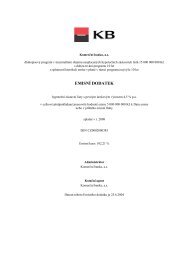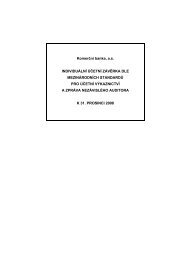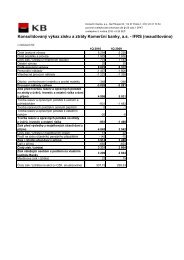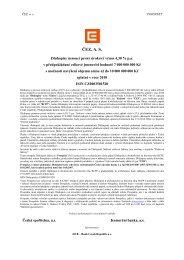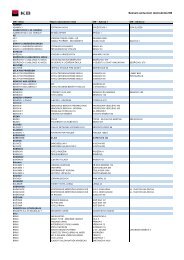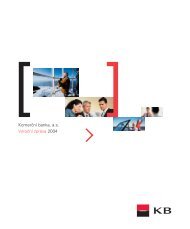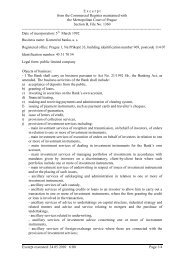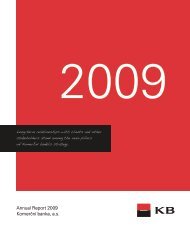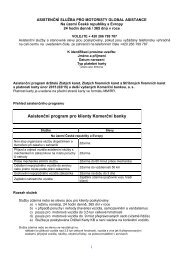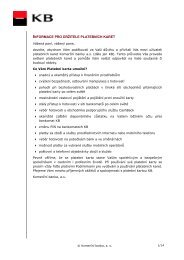KB prezent. angl - Komerční banka
KB prezent. angl - Komerční banka
KB prezent. angl - Komerční banka
Create successful ePaper yourself
Turn your PDF publications into a flip-book with our unique Google optimized e-Paper software.
124 ➔125<br />
Consolidated Financial Statements<br />
under IFRS<br />
Dividend income arising from securities is recorded as the dividends are declared and is included as a receivable in the balance sheet<br />
line Prepayments, accrued income and other assets and in Net profit/(loss) on financial operations in the profit and loss statement.<br />
Upon receipt of the dividend, the receivable is offset against the collected cash.<br />
Transactions with treasury shares (equity instrument) have a direct impact on the Group’s equity.<br />
Trading securities<br />
Securities held for trading are financial assets (equity and debt securities, treasury bills, bills of exchange and participation<br />
certificates) acquired by the Group for the purpose of generating a profit from short-term fluctuations in prices. Subsequent to the<br />
initial recognition, these securities are accounted for and stated at fair value which approximates the price quoted on recognised<br />
stock exchanges.<br />
Unrealised gains and losses arising from the fair value remeasurement of securities as well as realised gains and losses are<br />
recognised as income in the profit and loss statement line Net profit/(loss) on financial operations.<br />
All purchases and sales of securities held for trading that require delivery within the time frame established by regulation or market<br />
convention (“regular way” purchases and sales) are recognised as spot transactions. Transactions that do not meet the “regular way”<br />
settlement criterion are treated as financial derivatives.<br />
Investments held to maturity<br />
Investments held to maturity are financial assets with fixed or determinable payments and fixed maturities that the Group has the<br />
positive intent and ability to hold to maturity. Held to maturity investments are carried at amortised cost using the effective yield<br />
method.<br />
The Group assesses on a regular basis whether there is any objective evidence that an investment held to maturity may be impaired.<br />
A financial asset is impaired if its carrying amount is greater than its estimated recoverable amount which is equal to the present<br />
value of the expected future cash flows discounted at the financial instrument’s original effective interest rate. The amount of the<br />
impairment loss for assets carried at amortised cost is calculated as the difference between the asset’s carrying amount and its<br />
recoverable amount. When an impairment of assets is identified, the Group recognises provisions through the profit and loss<br />
statement line Provision for losses on securities.<br />
Securities acquired under initial offerings not designated for trading<br />
Securities acquired under initial offerings not designated for trading are financial assets that have originated as a result of the<br />
provision of cash, goods or services directly to the borrower. Securities acquired under initial offerings are valued on the same basis<br />
as investments held to maturity. These securities are reported on the balance sheet together with amounts due from banks or<br />
customers, as appropriate.<br />
Available for sale securities<br />
Available for sale securities are those financial assets that are not classified as financial assets held for trading, held-to-maturity<br />
investments or securities acquired under initial offerings not designated for trading. This portfolio comprises equity securities and<br />
debt securities, including asset backed securities, and participation certificates. Securities available for sale are measured on the<br />
same basis as securities held for trading.<br />
In circumstances where the quoted market prices are not readily available, the fair value of debt securities is estimated using the<br />
present value of future cash flows and the fair value of unquoted equity instruments is estimated using applicable price/earnings or<br />
price/cashflow ratios refined to reflect the specific circumstances of the issuer.<br />
If equity securities cannot be measured using the methods referred to above or on any other valuation basis they are carried at cost.



